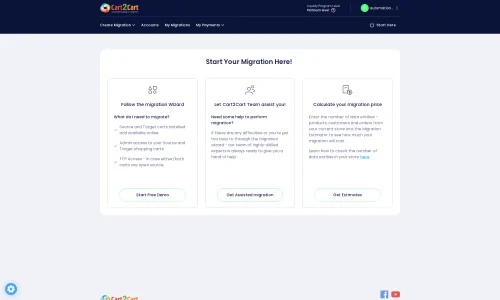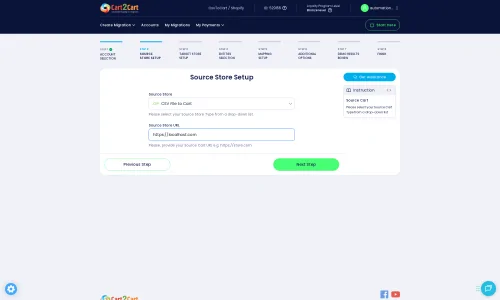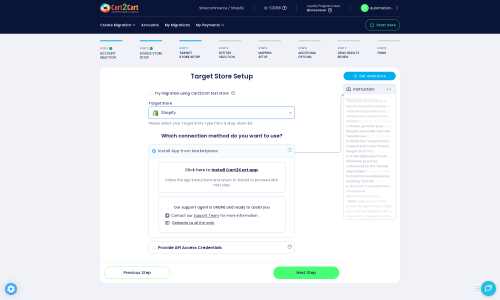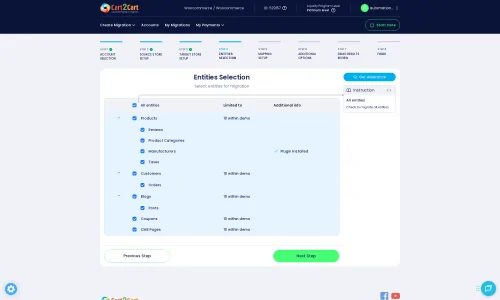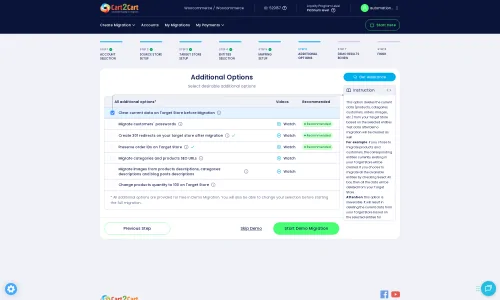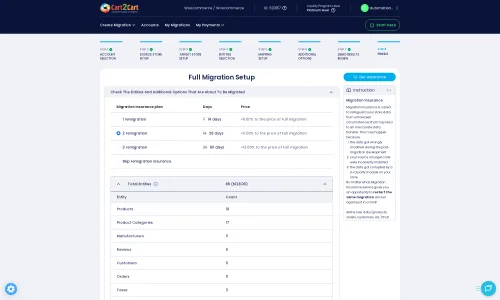Comersus Cart to Shopify Migration - Step-by-Step Guide & Expert Services
Comersus Cart to Shopify migration made easy and secure. When you're ready to move Comersus Cart store to Shopify, Cart2Cart is your trusted partner. Our automated service ensures a lightning-fast, highly secure, and SEO-friendly transfer of all your crucial data with absolutely zero downtime. Discover our comprehensive step-by-step guide if you prefer to switch from Comersus Cart to Shopify yourself, or let our dedicated migration experts seamlessly handle your entire data transfer. Trust Cart2Cart for a reliable Comersus Cart to Shopify migration.
What data can be
migrated from Comersus Cart to Shopify
-
Products
-
Product Categories
-
Manufacturers
-
Customers
-
Orders
Estimate your Migration Cost
The price of your migration depends on the volume of data to migrate and the additional migration options you pick. To check the price for Comersus Cart to Shopify conversion, click “Get estimates” and follow the suggested steps.
How to Migrate from Comersus Cart to Shopify In 3 Steps?
Connect your Source & Target carts
Choose Comersus Cart and Shopify from the drop-down lists & provide the stores’ URLs in the corresponding fields.
Select the data to migrate & extra options
Choose the data you want to migrate to Shopify and extra options to customise your Comersus Cart to Shopify migration.
Launch your Demo/Full migration
Run a free Demo to see how the Cart2Cart service works, and when happy - launch Full migration.
Migrate Comersus Cart to Shopify: The Definitive 2025 Guide
Seamlessly Migrate Your E-commerce Store from Comersus Cart to Shopify
Are you running an online store on Comersus Cart and contemplating a move to a more scalable, feature-rich, and modern platform like Shopify? This comprehensive guide is designed to walk you through the entire process of transitioning your valuable e-commerce data, including products, customer information, and order history, from Comersus Cart to Shopify. Given that Comersus Cart typically requires a file-based approach for data extraction, we'll focus on leveraging CSV files for a smooth and efficient data transfer to your new Shopify store. Our goal is to ensure data integrity and minimize downtime, allowing you to focus on growing your business on Shopify.
Replatforming your online store offers numerous benefits, from enhanced user experience and advanced marketing tools to improved mobile responsiveness and robust app integrations. By following these clear, actionable steps, you'll be well-equipped to perform a successful migration and unlock Shopify's full potential.
Prerequisites for a Successful Migration
Before initiating the data transfer, thorough preparation of both your source (Comersus Cart) and target (Shopify) stores is crucial. This step ensures a smooth process and helps in preventing potential data discrepancies or interruptions during the replatforming.
Preparing Your Comersus Cart (Source) Store:
- Data Export: As Comersus Cart typically necessitates a file-based migration, you'll need to export all your essential store data into CSV files. This includes products (with SKUs and variants), product categories, customer records, orders, product reviews, coupons, CMS pages, and blog posts. Ensure these CSVs are well-organized and validated for accuracy. For assistance with this, consider our CSV File Data Migration service.
- Data Review: Carefully review your Comersus Cart data. Clean up any redundant or outdated information to avoid migrating unnecessary data to Shopify.
- Backup Your Store: Always create a complete backup of your Comersus Cart database and files before starting any migration process. This provides a safety net in case any unforeseen issues arise.
- For more detailed guidance, refer to our FAQ on how to prepare your Source store for migration.
Preparing Your Shopify (Target) Store:
- Set Up Your Shopify Account: Ensure you have an active Shopify store. If you're on a 'Pause and Build' plan, be aware that it blocks orders, so plan your migration timing accordingly.
- Install the Cart2Cart Store Migration App: To facilitate the connection and data transfer, Shopify requires the installation of the Cart2Cart Store Migration App from its marketplace.
- Disable Notifications: It's highly recommended to disable email notifications on your Shopify store during the migration to prevent customers from receiving irrelevant updates during the data import process.
- Review App Requirements for Reviews: If you plan to migrate product reviews, be aware that Shopify often requires an app like AirReviews to manage and display them effectively.
- For comprehensive preparation steps, visit our guide on how to prepare your Target store for migration.
Performing the Migration: A Step-by-Step Guide
This section outlines the process of moving your store data from Comersus Cart (via CSV files) to Shopify using a migration wizard. Each step is accompanied by a visual reference to guide you.
Step 1: Get Started with the Migration Wizard
Begin your migration journey by navigating to the Cart2Cart migration wizard. This user-friendly interface will guide you through each stage of the data transfer process. Select the option to start a new migration.
Step 2: Connect Your Comersus Cart Store (Source)
As Comersus Cart isn't directly integrated via API, you'll select the 'CSV File to Cart' option as your source platform in the migration wizard. You will then upload the CSV files containing your exported Comersus Cart data. Ensure your CSV files are formatted correctly for seamless processing.
Step 3: Connect Your Shopify Store (Target)
Next, choose Shopify as your target e-commerce platform. The recommended method is to install the Cart2Cart app directly from the Shopify marketplace, which simplifies the connection process. Alternatively, you can opt to provide API access credentials for a manual connection. For guidance on API credentials, consult The Short & Essential Guide to Access Credentials for Cart2Cart.
Step 4: Select Data Entities for Transfer
Now, it's time to select the specific data entities you wish to transfer from your Comersus Cart CSV files to Shopify. This includes crucial elements such as products, product categories, customer records, orders, product reviews, coupons, CMS pages, and blog posts. You can choose to migrate all entities or selectively pick those relevant to your new Shopify store.
- Products: This includes product details, SKUs, images, descriptions, and variants.
- Product Categories: Your store's organizational structure for products.
- Customers: Customer accounts, billing, and shipping addresses.
- Orders: Historical order data, order statuses, and customer purchase history. Please note that for Shopify, you may want to review What will be the Fulfilled date on Shopify target store?
- Product Reviews: Valuable customer feedback on your products.
- Coupons: Discount codes and promotions.
- CMS Pages & Blog Posts: Informational content and articles.
Step 5: Configure Data Mapping
This critical step involves mapping data fields from your source CSV files to their corresponding fields in Shopify. For instance, you'll map customer groups and order statuses from Comersus Cart to their equivalents in Shopify. Accurate data mapping ensures consistency and integrity of your store's information post-migration.
Step 6: Choose Additional Migration Options
The wizard offers various additional options to tailor your data transfer. Consider the following:
- Clear Target Store Data: The option to clear current data on the target store before migration is useful if your Shopify store is brand new or you want to start fresh.
- Preserve IDs: Options like preserving original Order IDs or Product IDs can be vital for maintaining consistency with external systems or accounting records.
- SEO URLs & 301 Redirects: Migrating SEO URLs and creating 301 redirects are crucial for preserving your existing search engine rankings and link equity. This ensures customers and search engines are seamlessly redirected to your new Shopify URLs.
- Migrate Images in Description: Ensure product and category images embedded within descriptions are also transferred.
- Create Variants from Attributes: If your Comersus Cart uses attributes to define product variations, this option helps in creating proper product variants in Shopify.
- Migrate Groups to Tags: This can be useful for transferring customer groups or product manufacturers (from CsvToCart's `Products_Manufacturers` entity) into Shopify's tagging system for better organization.
Step 7: Launch the Full Migration
Before launching the full data transfer, we highly recommend running a demo migration. This allows you to preview a small subset of your data in Shopify, verify its accuracy, and make any necessary adjustments before committing to the full transfer. Once you're satisfied with the demo results, you can proceed with the full migration.
You might also consider adding a Migration Insurance Plan, which provides options for re-migrations in case you need to perform the transfer again or update data later. Learn more about how Migration Insurance works.
Post-Migration Steps
Completing the data migration is a significant milestone, but your work isn't quite finished. These post-migration steps are essential for ensuring your new Shopify store is fully optimized, functional, and ready for business.
- Verify Migrated Data: Conduct a thorough audit of your Shopify store. Check products, images, descriptions, categories, customer accounts, order history, and product reviews to ensure everything has transferred correctly and appears as expected.
- Configure Shopify Settings: Set up your shipping zones and rates, tax settings, payment gateways, and any other store-specific configurations within Shopify.
- Install Essential Apps: Explore the Shopify App Store for apps that enhance functionality, such as advanced SEO tools, marketing automation, customer support, and, as noted, a dedicated app for managing product reviews like AirReviews.
- Update DNS Settings: Point your domain name to your new Shopify store. This is the final step to officially launch your Shopify site.
- Implement 301 Redirects: If you didn't set up 301 redirects during the migration or if you've changed any URLs, manually configure them in Shopify to preserve your SEO rankings and guide visitors from old Comersus Cart pages to their new Shopify counterparts.
- Perform an SEO Audit: After your store is live, conduct an SEO audit to identify and fix any broken links, crawl errors, or indexing issues that might affect your search engine visibility.
- Thoroughly Test Your Store: Place test orders, verify checkout flows, test customer account functionalities, and ensure all forms and interactive elements work flawlessly.
- Consider Recent Data Migration: If you continued selling on Comersus Cart during the migration, utilize a Recent Data Migration Service to transfer any new orders, customers, or products added after the initial migration. You can choose specific entities for this.
- Celebrate Your New Store! Once everything is verified and optimized, announce your new Shopify store to your customers!
By diligently following these steps, you can successfully transition your e-commerce store from Comersus Cart to Shopify, paving the way for enhanced growth and a more robust online presence. Should you require further assistance or migration customization, our team is always ready to help. Don't hesitate to Contact Us for expert support.
Ways to perform migration from Comersus Cart to Shopify
Automated migration
Just set up the migration and choose the entities to move – the service will do the rest.
Try It Free
Data Migration Service Package
Delegate the job to the highly-skilled migration experts and get the job done.
Choose Package

Benefits for Store Owners

Benefits for Ecommerce Agencies
Choose all the extra migration options and get 40% off their total Price

The design and store functionality transfer is impossible due to Comersus Cart to Shopify limitations. However, you can recreate it with the help of a 3rd-party developer.
Your data is safely locked with Cart2Cart
We built in many security measures so you can safely migrate from Comersus Cart to Shopify. Check out our Security Policy
Server Security
All migrations are performed on a secure dedicated Hetzner server with restricted physical access.Application Security
HTTPS protocol and 128-bit SSL encryption are used to protect the data being exchanged.Network Security
The most up-to-date network architecture schema, firewall and access restrictions protect our system from electronic attacks.Data Access Control
Employee access to customer migration data is restricted, logged and audited.Frequently Asked Questions
Is my Comersus Cart data secure during the migration to Shopify?
Can customer passwords be migrated from Comersus Cart to Shopify?
Should I use an automated tool or hire an expert for Comersus Cart to Shopify migration?
What data entities can be migrated from Comersus Cart to Shopify?
Will my Comersus Cart store experience downtime during migration to Shopify?
How long does it take to migrate my store from Comersus Cart to Shopify?
How can I ensure data accuracy after migrating from Comersus Cart to Shopify?
How to avoid losing SEO rankings when migrating from Comersus Cart to Shopify?
Will my Comersus Cart store's design and theme transfer to Shopify?
What factors influence the cost of migrating from Comersus Cart to Shopify?
Why 150.000+ customers all over the globe have chosen Cart2Cart?
100% non-techie friendly
Cart2Cart is recommended by Shopify, WooCommerce, Wix, OpenCart, PrestaShop and other top ecommerce platforms.
Keep selling while migrating
The process of data transfer has no effect on the migrated store. At all.
24/7 live support
Get every bit of help right when you need it. Our live chat experts will eagerly guide you through the entire migration process.
Lightning fast migration
Just a few hours - and all your store data is moved to its new home.
Open to the customers’ needs
We’re ready to help import data from database dump, csv. file, a rare shopping cart etc.
Recommended by industry leaders
Cart2Cart is recommended by Shopify, WooCommerce, Wix, OpenCart, PrestaShop and other top ecommerce platforms.



